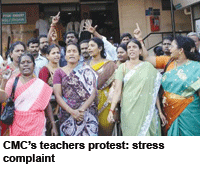The third annual day celebrations of the Chennai Girls Higher Secondary School (CGHSS) of the Chennai Municipal Corporation (CMC) on March 1 were marred by the attempted suicide of science teacher P. Jagatheeswaran (41) who consumed hydrochloric acid in the school’s laboratory. According to CGHSS sources, Jagatheeswaran was reprimanded for neglect of duty by the corporation’s education officer, K. Ravichandran, present at the school on an inspection visit.
The incident shocked and enraged the 4,000-strong faculty of CMC which manages 281 free-of-charge K-10 schools, affiliated with the Tamil Nadu state board in the city. When Jagatheeswaran was rushed to a hospital in critical condition, hundreds of them besieged the corporation headquarters to protest “inconsiderate education officers”. Bowing to their demands, CMC suspended Ravichandran and the school’s headmaster, R. Thyagarajan.
 According to CGHSS teachers, the suicide attempt was the fallout of a “trivial administrative issue”. Education officer Ravichandran had asked four science teachers for the attendance register and science records of class X students. When he learnt the students were not carrying their notebooks with them, being the school’s annual day, and that teachers had not signed them, he demanded a written explanation for the delay. Despite the teachers’ repeated pleas to withdraw his request, Ravichandran didn’t relent. Unable to bear the stress, Jagatheeswaran consumed acid in the school lab.
According to CGHSS teachers, the suicide attempt was the fallout of a “trivial administrative issue”. Education officer Ravichandran had asked four science teachers for the attendance register and science records of class X students. When he learnt the students were not carrying their notebooks with them, being the school’s annual day, and that teachers had not signed them, he demanded a written explanation for the delay. Despite the teachers’ repeated pleas to withdraw his request, Ravichandran didn’t relent. Unable to bear the stress, Jagatheeswaran consumed acid in the school lab.
This tragic incident over a trivial issue has turned the spotlight on high stress levels Chennai corporation school teachers experience, and the various factors which have contributed to it. Currently 4,000 teachers of CMC’s 281 schools teach and mentor 100,000 students. Inevitably, CMC schools suffer severe infrastructure deficiencies and are characterised by poor learning outcomes and declining enrolment. In April 2010, CMC upgraded the image of its schools by renaming them Chennai Schools, giving them fresh coats of paint and introducing a system of fortnightly inspections by education officers in Chennai’s ten zones to ensure improved learning outcomes. CMC also decreed that schools which scored 100 percent pass percentages in public examinations would be rewarded.
Two years later, the great expectations of CMC officials remain unfulfilled. Continuous pressure from civic officials to improve learning outcomes in CMC’s crumbling schools — ill-equipped in terms of libraries, laboratories and lavatories and suffering high teacher absenteeism — has served only to raise teachers’ stress levels. “We are under constant pressure to obtain 100 percent pass results in board examinations. If a few students fail, we are grilled and reprimanded by education officials,” says a corporation school teacher, speaking on condition of anonymity.
Falling enrolment, fear of closure and transfers are adding to teachers’ tensions. The aggregate enrolment in CMC’s primary and upper primaries declined last year, although it is “satisfactory” in high and higher secondary schools. According to CMC statistics, the total number of students enroled in primary and upper primaries declined from 63,641 in 2010-2011 to 58,929 in 2011-2012, and the aggregate number of students in class I across all schools is a mere 5,138.
“There is stiff competition from private and aided schools sited near corporation schools, with parents preferring to send their children to private English-medium schools. Although there are currently over 100 corporation schools offering English-medium education, parents hesitate to send their children to CMC schools as they are aware that their English standards are poor and most don’t have proper laboratory facilities, playgrounds and extra-curricular activities. Moreover, the CMC does not recruit separate teachers for each subject and there are long delays in teacher appointments. All these factors weigh on teachers working in an unsupportive environment,” says Dr. P. Krishnamoorthy, who heads Child Relief and You (CRY), Tamil Nadu.
However, some educationists in the state are impatient with the high stress argument of CMC teachers who have an infamous reputation for truancy and militant unionism. “CMC school teachers are well paid and infrastructure has been developed in most schools. They should try to give their best instead of complaining about stress,” says N. Jayalakshmi, retired headmistress of a government school in Chennai.
Even as the debate on stress and pressure rages, CMC has announced a slew of measures to upgrade its schools. In the corporation’s budget 2012-2013, Rs.15 crore has been provided for education — a whopping 150 percent increase over the previous year apart from committing Rs.21 crore as capital expenditure for the same period. Among the provisions made are wired smart classrooms for 38 high and 32 higher secondary schools, music rooms, spoken English classes and sports facilities. But, while the corporation plans to expend substantial amounts on infrastructure development and improving learning outcomes in its 281 schools, it has deliberately ignored the massive elephant in the room: lack of English-medium or even proper focus on English language learning from class I.
With the people’s representatives out of step with constituents, it’s hardly surprising that heads of households from even the poorest families are fleeing from free-of-charge CMC primaries to fee-levying private schools. That’s the prime cause of teacher stress in Tamil Nadu’s government — including CMC — schools.
Hemalatha Raghupathi (Chennai)























